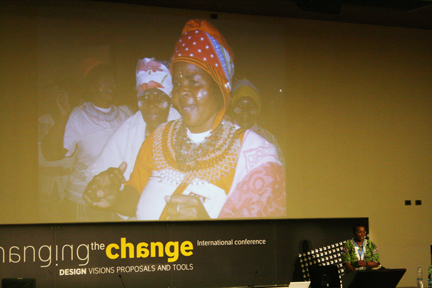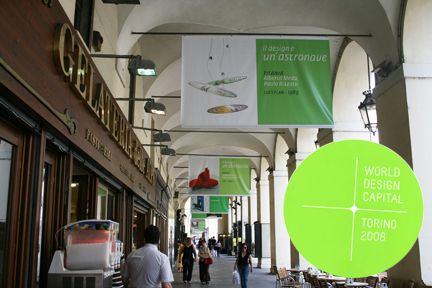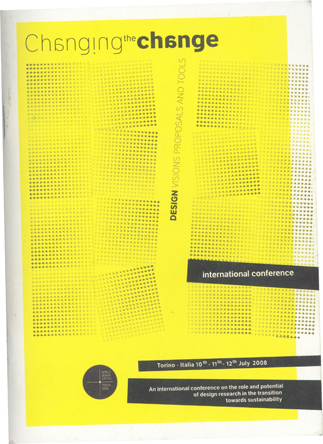David Stairs

Ezio Manzini is an optimist. Four years ago he envisioned a design conference dedicated to the notion that although things must, will, and do change, perhaps we ought to spend more time planning that evolution. This vision was realized last week at the Changing the Change conference held in the World Design Capital at Torino’s Institute of Biotechnology, just a little way up via Nizza from Matté Trucco’s famous Fiat Lingotto plant.
 Fiat Lingotto
Fiat Lingotto
Professor Manzini has been a hero of mine ever since I read “Prometheus of the Everyday” many years ago. And he didn’t disappoint with his opening remarks at the conference. Peppered with toothsome morsels such as, “Being a designer means being a realistic optimist,” and “Sustainability should be the meta-objective of every design research activity,” Manzini delivered a rousing challenge to practice good design research in pursuit of sustainability and an effort to “live better, consuming less.”
This is a hard act to follow and, despite invited guests that included Nigel Cross, Jorge Frascara, Luigi Ferrara, and Josephine Green, the conference struggled to rise to the occasion. Keynote speaker Bill Moggridge of IDEO, for instance, gave a presentation loaded with video clips of sexy sustainables, like a water-filtering tricycle, and Design Accord, the website he described as “the potential wikipedia for design.” More often than not Moggridge glossed the niggling details, like the fact that the trike wouldn’t be much good over anything other than flat ground, or that the numbers for his wiki, 100,000 members in less than a year and 4,000,000 hits per month, seem unrealistically high figures at best.
 Lingotto ramp
Lingotto ramp
Despite the usual baggage of high-profile personalities, for me the conference was saved by presentations from the so-called “bottom of the pyramid.” Geetha Narayanan of the Srishti School of Design in Bangalore gave a marvelous presentation. Her tale about how a group of small dairy farmers, there were no designers involved, created a cooperative now 2.7 million producers strong which developed into to Amul, Asia’s largest dairy brand, bodes well for all of us. And for once it was an African, Mugendi M’Rithaa, a Kenyan teaching at Cape Peninsula University of Technology in Capetown, South Africa, who literally stole the show. His plenary presentation about the importance of traditional holistic African thinking to design was not only graphically beautiful, but struck absolutely the perfect chord for sustainability.

Mugendi M’Rithaa at the podium
At the heart of this conference were the papers delivered by participants from 27 countries in six categories and published by Allemandi online in time for the conference. Given its location in Turin, I had expected the event to be well attended by Europeans, but with only five papers from the USA (Banny Bannerjee of Stanford Design Program, Mariana Amatullo from ArtCenter’s Designmatters, Lynda Grose from CCA, Robert Kirkbride from Parsons, and myself) and over 50 from Italy things felt lopsided. The Eurocentric bias of the event took an ugly turn when Christian Guellerin of Cumulus got some cheap laughs with a tasteless joke about how only one man in America (at the Rocky Mountain Institute, of course) had thus far signed the Kyoto Accord. Fortunately, not everyone was amused. David Raffo, a British engineer sitting beside me turned and said, “That’s not right. Dozens of American cities have signed.”

Banners along via Po
When it came to big change ideas, all the Utopianists were there from the young man who would reduce all world systems to a 30cm cubit to the demon networkers with improbable stats. In my life Utopia does not equate with Imagination, the latter representing the extreme of what’s possible. Luisa Collina from Milan Polytechnic praised the value of “Having one’s feet on the ground and head in the clouds.” It all becomes a matter of whether one prefers hypoxia to death by PowerPoint bullets.
Let alone writing, most designers are often not very good speakers. This is a deficiency that conference organizers usually overcome by hiring a master of ceremonies and loading the program with talking heads who make the conference rounds. In a venue dedicated to academic research this, of course, was not possible, so one spent much of the time rushing in and out of sessions in progress and missing many altogether. All tolled, 138 papers (not all delivered) were crammed into four 2.5-hour blocks, twenty minutes for each presentation. With so much overlap, it was nearly impossible to attend a fraction of the presentations, and many good ideas went unheard. Fifty fewer papers would have made the conference less democratic perhaps, but much more manageable, without stilling independent voices or disadvantaging PhD. candidates.
During the conference introduction conference organizer Claudio Germak gave attendees an overview of the efforts to make a sustainability conference sustainable. Little keepsakes, like the biodegradable Aurora “Corn Pen,” a ballpoint pen made from cornstarch, or the free availability of City of Torino touring bikes to attendees, while considerate, didn’t really do much to offset the damage of the thousands of unrecyclable solo cups used, or the mylar conference banners that floated in the courtyard of the Institute.

John Thackara asked me what conferences I enjoyed attending and I gave him my standard reply: “None.” Of course, this response is at odds with the collective wisdom and makes me a heretic. But, in my opinion, conferences seldom live up to their billing or themes. This one, though sincere, might have been more effective if money had been put into purchasing carbon credits to offset the jet fuel used by participants to fly into Torino rather than into branding the gala conference dinner at the Castello del Valentino with custom made “arrow” tables in keeping with the conference logo.
Conferences, especially the design variety, do not generally present basic research. But that’s OK. Human beings are sociable creatures, and traveling to a foreign city to mingle with familiar friends and make new ones is a distinctly human enterprise. Assigning a degree of seriousness to the proceedings is another thing entirely, yet we do. Many of the participants in Turin were obviously pushing personal or professional agendas: books, blogs, academic programs, corporate initiatives. The academic-speak was flying thick and fast, with concepts like “networking” and “matrix tools” and terms like “change agent” and “urban narrative” on everyone’s lips. But I fear the actual impact of the conference in design circles will be small, and on the world as a whole negligible.

Which begs some obvious questions: Can designers have a more significant impact on our contemporary world? Yes and no. Their influence, though by no means nugatory, is a lot less universal than they would have you believe. Can this change? Maybe, maybe not. Ostensibly setting the agenda for design research to come, Changing the Change felt more like a crisis narrative for design than a recipe for rescuing the environment. The world is no doubt in serious need of women and men of good faith who are willing to tighten their belts and think straight. Twenty years after Bruntland, whether sustainability develops into a formal agenda for design remains to be seen. It’s going to take less talk and a lot more action. We’ll probably have to change human nature before we can seriously talk about changing Change. And, you know I’m going to say it, the more things change, the more they stay the same.
David Stairs is the founding editor of Design-Altruism-Project
P.S. In addition to the papers, consensus proposals in six areas of potential research interest will soon be posted on the CtC website. Stay tuned.











July 21, 2009 at 10:45 pm
I don’t have any deep insights to share, but that corn pen is pretty awesome.
July 16, 2008 at 3:12 am
I sense and share the weariness of the conference-goer, particularly when it is about something as ideologically- and emotionally-charged as the future. Looking at the conference website and the long list of paper submissions, I don’t see too much on-the-ground work. Nothing against student and researcher presentations, but I want to see people doing things, with just one difference: they don’t have to be succeeding. At another ideologically-charged conference long ago, I made a plea for us to share failures rather than weak efforts dressed up as successes – which achieve no more than promote the mutual back-scratching conference culture. Who’s for a “conference of honest failures”, then? I’ve got some stories I’d love to pull out of my closet.
Now that my mind’s on a roll, I believe design would be really well-served by adopting radically new, different and future-compatible exemplars – and reverse-engineering the discipline from their examples. I’d love a conference where they presented and we just listened – and went home with the task of reconfiguring our discipline. We need to compile a list of such people, I suspect many of whom are not very well-known outside their localities. Some names I’ve got so far: Enrique Penalosa (ex-mayor of Bogota), Lyonpo Jigme Thinley (pioneer of GNH, now the Prime Minister of Bhutan) and Margrit Kennedy (no-interest money proponent). Yes, this does sound a lot like what the Doors of Perception was about, but somehow it’s not delivered on the promise to transform the discipline through such examples. Then again, perhaps it’s the notorious indiscipline of our nondiscipline at play!